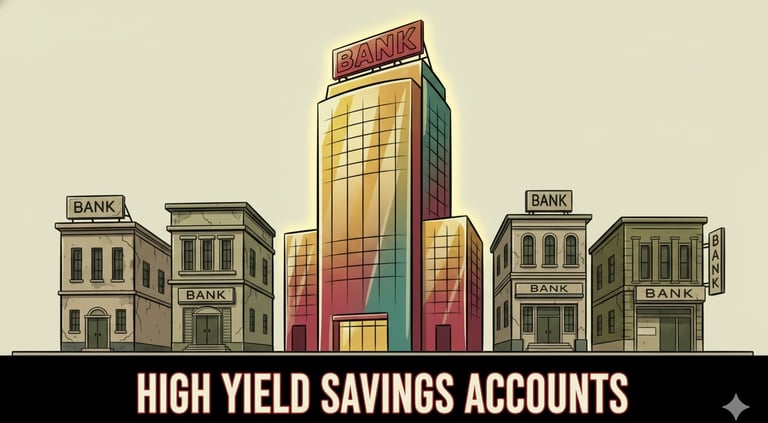FREE AI Analytics Tool for Health Reports and Scans available.
High-Yield Savings Accounts: A Retiree's Guide to Earning More Interest
Retirees, unlock higher earnings! Discover what high-yield savings accounts are, how they work, and why they're a smart, low-risk way to boost your retirement interest.
PASSIVE INCOME TIPS
11/18/20253 min read


Introduction: Is Your Savings Account Just Taking Up Space?
Remember the good old days when your savings account actually paid you a decent chunk of change? For many retirees, those days feel like a distant memory, with traditional bank accounts offering interest rates so low they barely keep up with inflation. It's frustrating to watch your hard-earned nest egg just sit there, barely growing. But what if I told you there's a way to make your money work harder for you, even in retirement, without taking on unnecessary risk?
I recently bumped into my old neighbor, Frank, a fellow retiree, who was grumbling about his paltry savings interest. I told him about high-yield savings accounts, and his eyes lit up! He'd heard the term but never really understood the benefit. This guide is for all the Franks out there.
What Exactly is a High-Yield Savings Account (HYSA)?
At its core, a high-yield savings account (HYSA) is simply a savings account that offers significantly higher interest rates than a traditional savings account. While traditional accounts might offer a meager 0.01% to 0.10% Annual Percentage Yield (APY), HYSAs can offer anywhere from 3.00% to over 5.00% APY, depending on the market.
Key Differences from Traditional Accounts:
Higher Interest Rates: This is the big one! Your money grows faster.
Online Focus: Many HYSAs are offered by online-only banks, which have lower overhead costs and can pass those savings on to you in the form of better rates.
FDIC Insured: Just like traditional accounts, HYSAs from FDIC-insured banks are protected up to $250,000 per depositor, per institution. Your money is safe!
Why Should a Retiree Consider an HYSA?
Retirement often means a shift from accumulating wealth to preserving it and generating income. HYSAs fit perfectly into this strategy.
Steady, Low-Risk Growth: Unlike volatile stock investments, HYSAs provide predictable interest earnings with virtually no risk to your principal, as long as it's FDIC-insured. This makes them ideal for emergency funds or money you plan to use within a few years.
Accessibility: While some HYSAs might have minimum balance requirements, your money remains liquid, meaning you can access it when you need it, typically through electronic transfers. This is crucial for unexpected expenses.
Combatting Inflation: While not a perfect solution, the higher APY of an HYSA helps to mitigate the eroding effects of inflation on your savings much better than a standard savings account. For example, a 2023 report by the Federal Reserve noted that inflation can significantly diminish purchasing power over time, making higher interest rates more important than ever for fixed-income individuals.
Peace of Mind: Knowing your money is both safe and earning a competitive rate can provide significant peace of mind in retirement.
Finding the Right HYSA: What to Look For
Choosing an HYSA isn't complicated, but a little research goes a long way.
APY (Annual Percentage Yield): This is the most important factor. Always compare APYs across different banks. Remember, rates can fluctuate, so keep an eye on market trends.
FDIC Insurance: Crucial. Always confirm that the bank offering the HYSA is FDIC-insured. You can usually find this information clearly displayed on their website.
Fees: While many HYSAs are fee-free, some might charge for specific services or if your balance drops below a certain threshold. Read the fine print! According to a 2024 survey by Bankrate, while over 80% of top HYSAs have no monthly fees, it's always wise to check.
Minimum Balance Requirements: Some HYSAs require a minimum deposit to open or to earn the advertised APY. Ensure these align with your financial situation.
Ease of Use: Consider the online banking platform, mobile app, and customer service. You want an account that's easy to manage.
Making the Switch: A Simple Process
Opening an HYSA is typically straightforward:
Online Application: Most HYSAs are opened online in minutes.
Fund Your Account: Link an existing checking or savings account to easily transfer funds.
Set Up Direct Deposit (Optional): If you receive pension or social security payments, you might be able to direct a portion to your HYSA for automated savings growth.
In 2023, nearly 60% of consumers preferred opening new bank accounts online, highlighting the convenience of digital banking options for all age groups (Statista, 2023).
Conclusion: Give Your Retirement Savings the Boost They Deserve
Don't let your hard-earned retirement savings languish in a low-interest account. High-yield savings accounts offer a fantastic, low-risk opportunity to generate more interest and help preserve your purchasing power. It's a simple yet powerful financial tool that can provide significant benefits and greater peace of mind during your golden years. Take a few minutes to research and compare options – your future self will thank you!
Call to Action: Have you used a high-yield savings account in retirement? Share your experiences and tips in the comments below!
Disclaimer: This article is for informational purposes only and does not constitute professional advice.

Address
Blk 8 Cantonment Close
SIngapore